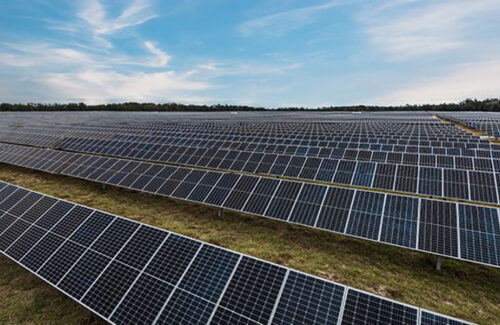A review by the SUN DAY Campaign of data recently released by the Federal Energy Regulatory Commission (FERC) and the U.S. Energy Information Administration (EIA) confirms that 2024 has begun with strong growth by solar in both total capacity and electrical generation. This is projected to continue for at least the next two to three years.

Credit: Duke Energy
In its latest “Energy Infrastructure Update” (with data through January 31, 2024), FERC reports that solar accounted for 2.527 GW of new generating capacity in the first month of this year – or 87.3% of the total new generating capacity. That is the second highest monthly total ever reported for solar, behind only the prior month when 4.979 GW was added. Renewable sources accounted for 98.3% of capacity additions in January.
The new solar and wind brought the total available installed generating capacity of renewable energy sources (also including hydropower, biomass and geothermal) up to 376.33 GW or 29.17% of all U.S. generating capacity. That is more than the installed capacity of either coal (207.15 GW) or nuclear power (103.27 GW).
Installed utility-scale solar capacity (104.61 GW) alone now exceeds that of not only nuclear power but also hydropower (101.41 GW), and that does not include the additional capacity of small-scale, distributed solar (for example, rooftop systems) which accounts for more than 30% of all solar.
FERC suggests that utility-scale solar capacity should also exceed that of wind within the next two to three years. Between February 2024 and January 2027, FERC anticipates net “high probability” additions of solar (including system retirements) to total 85.419 GW. There may be as much as 218.646 GW of new solar in the three-year pipeline.
FERC also expects 24.443 GW of net new wind additions plus 561 MW of net new hydropower and 400 MW of net new geothermal. The installed capacity of coal is expected to plummet by 22.24 GW, and natural gas and oil would fall by 3.131 GW and 2.051 GW, respectively.
With just “high probability” additions by early 2027, solar could account for 13.83% of total available installed generating capacity while wind would be 12.79%. Taken together, all renewables would provide 35.45% of the total – approaching natural gas at 40.88% and surpassing coal at 13.45%, nuclear power at 7.60% and oil at 2.48%.
In its latest monthly “Electric Power Monthly” report (with data through January 31, 2024), the EIA stated that the combination of utility-scale and small-scale solar increased by 20.5% compared to the first month of last year. As a result, solar’s share of total U.S. electrical generation in January 2024 rose to 3.8% compared to 3.4% a year earlier. Electrical generation by the mix of renewables, including small-scale solar, still out-performed coal by 0.7% and surpassed nuclear power by 10.2%. Despite the lower renewable energy numbers for January, EIA still anticipates significant growth in electrical generation by renewables this year and next.
In its latest “Short-Term Energy Outlook,” EIA foresees the mix of utility-scale renewables to increase their share of total U.S. electrical generation from 21.1% in 2023 to 23.2% in 2024, and then to 25.2% in 2025. Solar alone would expand by 76.1% between 2023 and 2025 while electrical generation by wind would increase by 8.9%. The generating capacities of solar and wind would grow by similar amounts. EIA also expects electrical output by hydropower, geothermal and biomass combined to rebound this year.
“The rapid growth by solar in both capacity additions and electrical generation shows no signs of stopping or slowing down,” said Ken Bossong, executive director the SUN DAY Campaign. “Despite a slow start in January, the mix of all renewables seem poised to continue expanding its share of U.S. electrical generation and generating capacity this year and beyond.”
News item from The SUN DAY Campaign





Tell Us What You Think!